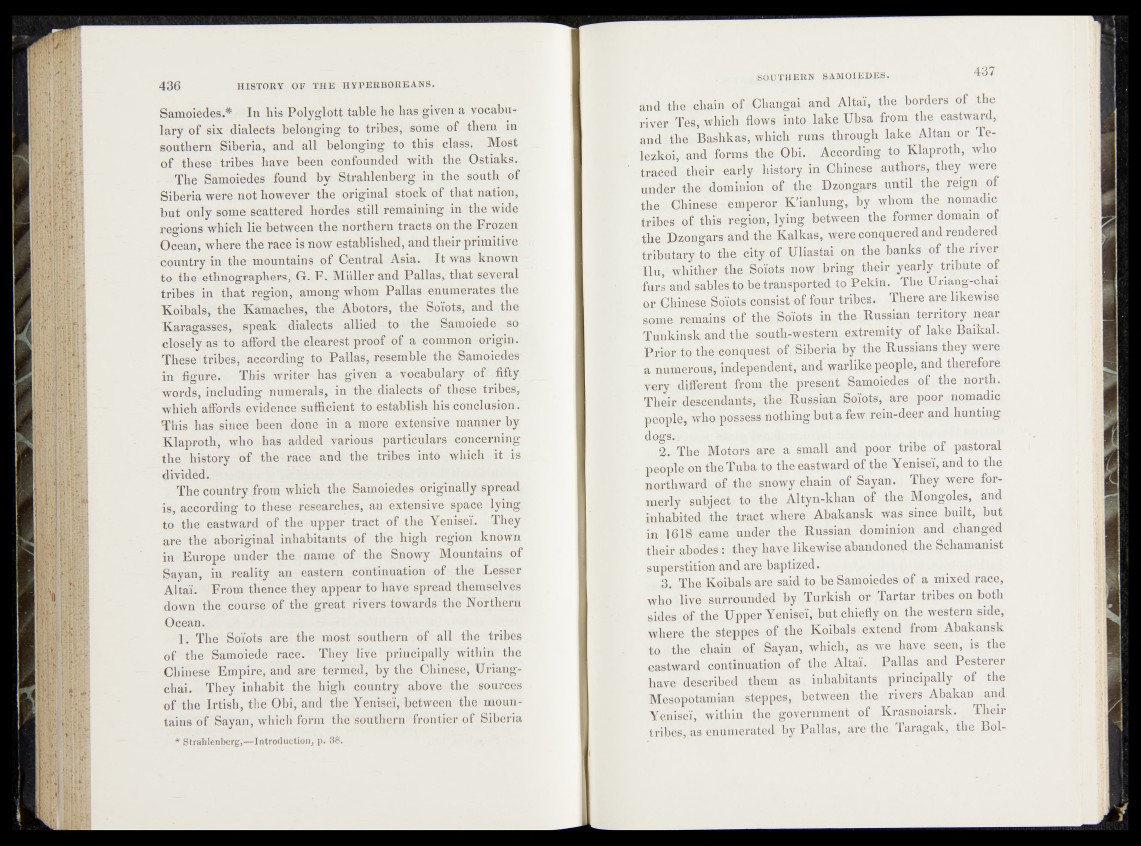
Samoiedes.* In his Polyglott table he has given a vocabulary
of six dialects belonging to tribes, some of, them in
southern Siberia, and all belonging ‘to this class.. Most
of these tribes have been confounded with the Ostiaks,
The Samoiedes found by Strahlenbergvip the south of
Siberia were not however the original stock of that nation,
but only some scattered hordes still remaining ^ the widp
regions which lie between the northern tracts on the Frozen
Ocean, where the race is now established, and their primitive,
country in the mountains of Central Asia. It was known
to the ethnographers, G. F. Muller and Pallas, that several
tribes in that region, among whom Pallas enumerates the
Koibals, the Kamaches, the Abotors, the-.S©$ot6j and the
Karagasses, speak dialects allied to the „Samoiede so
closely as to afford the clearest proof of a common origin.
These tribes, according to Pallas, resemble th-e^ Samoiedes
in figure. This writer has given a vocabulary of, fifty,
words, including numerals, in the.dialects of the&ejtribes,
which affords evidence sufficient to establish his conclusion."
This has since been done in a more extensive, manner by
Klaproth, who has added various particulars concerning
the history of the race and the tribes into-which it is
divided.
The country from which the Samoiedes originally spread
is, according to these researches, an extensive space lying
to the eastward of the upper tract of the Yenisei. -They
are the aboriginal inhabitants of the high region known
in Europe under the name of the Snowy Mountains of
Sayan, in reality an eastern continuation of the Lesser
Altai. From thence they appear to have spread themselvbs
down the course of the great rivers towards the Northern
Ocean.
1. The Soiots are the most southern of all the tribes
of the Samoiede race. They live principally within the
Chinese Empire, and are termed, by the Chinese, Uriang-
chai. They inhabit the high country aboVe the sources
of the Irtish, the Obi, and the Yenisei, between the mountains
of Sayan, which form the southern frontier of Siberia
* Strahlenberg,—Introduction, p. 38.
and apd Altai, the borders of the
river, Teswwhifib-Æ» into- lakedJ'bsa from the eastward,
and the Bashes, which „runs through, lake Altan or Te-
lezkcd, and forms th^OhJB to Klaproth, who
traced tlie|r early jblh^ise.sei^thors, they were
under the dominion of the» Dzongar^jrntil the reign of
the, Chinese,,ep;pe®f iK’ianlu^j by iwlio^ça nomadi©
tribes'- of this< reg iën ^|^n ^|ç^weei]l the former domain of
the Dzongars and the Kalkas, -^yetconquered and^endered
tributary to the city^qf^Uliastai on the banks of thê^iye |
Ilu^whither tfee^qiofcs n ow ,h rin ^ t^ ir,^|arly^|^|)Ute of
durs-and s a b l^ o be transported^ Pelfcim The Uriang-ehai
orCbWe^ôidtSiConsis^ Épür trib<^ There likewise
some remains of t h ^ S # t s in .the,Russian territory near
Tunkinsk and thed^puth-wâstern e^trei|^y=pf lake Baikal.
P r io r i the conquest Qf;£iberia^y-tbe Russians.-they .were
a numerous/ independent a n d warlike,pgapl-e,^nd therefore
very different thppresent,, Samoipd^ of the north.
Their des&eJulants, -»the Ru^ia-nj^oiqtSj ■ nr© nomadic
people, who potseJâinothing,buta few rein-deer, and hunting
dogs.—. > •. - ' -
„.,g. The Motors are a small and poor tribe of. pastoral
people on the Tuba to the eastward of the Yen/fei, anddo the
northward of thm^nowy* ©bain \ o^Sayan. They, were, formerly
subject* to .the ALty-n-khan of the and
inhabited the tract ^here-jAbakansk Was siu ^b u ilt, but
in 1 6 1 8 came under the Russian, d@minjon and changed
their abodes? they hav% likewise abandoned jffe© Schamanist
superstition and are baptized. . * 'w *
3 . The Koibals are sai.d to be Samoiedes,of a mixed race,
who live surrounded by Turkish or Tartar tribes on both
sides, of the Upper Yenisei',' but chieflyvdn.the western side,
where the steppes of the Koibals extend from Abakansk
to the chain of Sayan, which, as-we, have seen;â s the
eastward continuation of the Altai. Pallas and Pesterer
have described,them as inhabitants principally of the
Mesopotamian steppes, between the, rivers Abakan and
Yenisei, within the government of Krasnoïarsk. Their
tribes, as enumerated by Palias, are the Taragak, the Bol